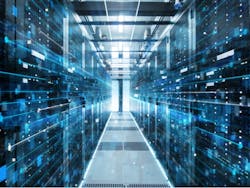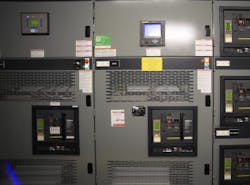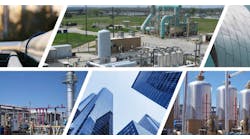Operators of data centers — which consume high amounts of electricity per square foot of space — generally choose diesel backup systems over cleaner microgrids, sticking to the tried and true and believing that diesel provides the best reliability option.
But that conservative choice yields emissions of carbon and particulates and misses opportunities to use cleaner microgrids to lower emissions and costs.
That’s the word from microgrid industry members, some of whom are just now beginning to crack the market. They say their efforts to educate data center operators about microgrids’ environmental and cost advantages are slowly beginning to pay off. And, microgrids can meet the data center industry’s requirements for reliability, the industry members say.
Data centers, which account for about 2% of US electricity use, are among the most energy-intensive building types, using 10 to 50 times the energy per floor space of a typical commercial office building.
“This sector is highly dependent upon electricity for continuous business operations and any disruption in available power can have a significant impact on reputation, loss of customers, financial losses, etc.,” said Eric Dupont, executive vice president and chief development officer at PowerSecure. “This appears to drive data centers to continue to follow their traditional and proven model of backup generation systems sequenced to operate when grid power outage occurs.”
Afraid of change?
With microgrids, data centers can reduce the high cost of energy by participating in market programs such as emergency response, demand response and curtailment programs, Dupont noted. But the industry hasn’t adopted microgrid use because it doesn’t want to disrupt its traditional model, he said.
What’s more, data center operators are less interested in resiliency than energy costs, said Tom Poteet, vice president of corporate development at Mesa Natural Gas Solutions.
And many data centers are part of a network of data centers within one company, with all the data from one center backed up somewhere else. “So as long as data is preserved, a temporary reduction in computing power may be deemed to be tolerable,” said Poteet.
To lower their carbon footprints, some data centers invest in large arrays of solar panels located off-site, rather than choose microgrids with renewable components, he said.
Added Mike Byrnes, senior vice president of Veolia North America, “The more progressive operators like Facebook, Google, Microsoft, Equinix are signing virtual PPAs [power purchase agreements] for utility scale solar and wind farms to cover their green requirements.”
Meanwhile, data centers’ diesel generators are operating more often, especially in California, releasing carbon and particulates. In the San Francisco Bay area of California, an air quality management district is concerned.
“Whenever there’s a state of emergency in the state of California, the diesel generators run. That has not gone unnoticed. The run hours are more frequent than emergency only,” said Allan Schurr, chief commercial officer at Enchanted Rock. This means that the diesel generators are not just running during outages, they also are called on to run when there’s an emergency on the grid involving low power resources.
Concern in California
The Bay Area Air Quality Management District (BAAQMD) sent a letter to the California Energy Commission (CEC) last March about two data center buildings Microsoft proposed on 64.5 acres in San Jose. Forty 3-MW Tier 4 diesel generators would serve the buildings’ 92-MW load diesel, according to the letter.
“The Air District is concerned about the potential for any increase in emissions that could result from the project,” said the Bay Area air district. “To achieve the most health protective air quality conditions and to reach climate goals, the Air District highly recommends the CEC consider requiring the project applicant to use the cleanest available technologies and fuels possible during all phases of the project.” That would include zero-emission sources for energy and backup generation.
“Whenever there’s a state of emergency in the state of California, the diesel generators run. That has not gone unnoticed.” — Allan Schurr, Enchanted Rock
The district also said that several Bay Area data centers were using backup diesel generators for reasons other than routine testing and maintenance.
“The issue raised by the BAAQMD is that assuming limited hours per year for diesel generators (for testing, maintenance and the infrequent outage) as traditionally has been done understates the new reality of system emergencies when the state authorizes/orders diesel generators to run,” explained Schurr. Regulators should use the increased hours to evaluate environmental impacts, not the minimal testing and maintenance hours only.
Schurr said that microgrids with renewable natural gas can achieve net-zero emissions, and that it’s not cost prohibitive.
“We have data to show that Tier 4 diesel might be 10 times cleaner than Tier 2, but 10 times dirtier than natural gas microgrids,” Schurr said.
Data centers that use cleaner microgrids
In spite of the obstacles to convincing data center operators to invest in clean microgrids, a few data centers have moved forward with microgrids.
For example, PowerSecure installed a microgrid at the Aligned Data Centers site in Plano, Texas. The facility does use five 2.5-MW Tier 4 diesel generators. But the microgrid emits one-tenth of the particulates of conventional backup generators, says Jacob Carnemark, former CEO of Aligned Data Centers in a video from PowerSecure. He added that the microgrid’s energy efficiency and ability to coordinate with the grid during peak load times create “one of the most sustainable data centers on the planet.”
In another recent project, Enchanted Rock provided a microgrid with natural gas generators, through its partner Entergy, to the US Army Energy Research and Development Center’s supercomputing data center in Vicksburg, Mississippi. The microgrid’s main purpose is to provide power during an outage. But the microgrid can provide capacity to the grid during peak usage times, said a press release from the US Army Energy Research and Development Center.
More microgrids are on the horizon for data centers, said Bill Kleyman, executive vice president of digital solutions at Switch, a large data center operator headquartered in Las Vegas, Nevada.
“Our industry is still getting caught up on the education and the capabilities of modern microgrids, which will become more prevalent in this space. Diesel is not the fuel of the future,” he said.
Track news about data center microgrids. Subscribe to the free Microgrid Knowledge Newsletter.









